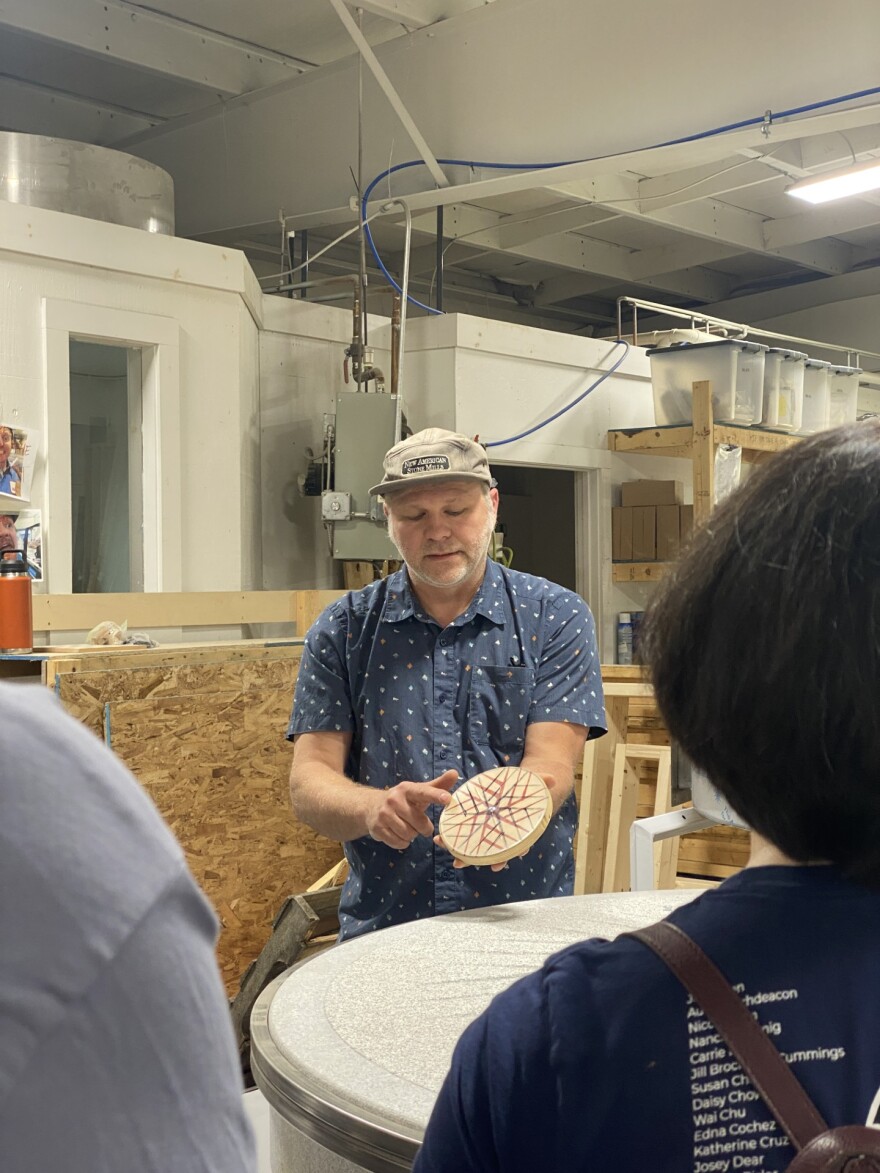I’m sandwiched between bread bakers from across the country on a bus tour, hosted by the Bread Bakers Guild of America. There’s no camp songs or cheers on the bread bus, but the bunch is lively with anticipation, here to get a picture of a new reality: You can now get a loaf of bread made with 100% local ingredients — including flour — in Vermont.
Stop No. 1: Nitty Gritty Grain Company in Charlotte.
The wheat fields are lush and expansive, framed by Camel's Hump’s crest on a mountainous horizon line.

David Kenyon, with Nitty Gritty, gestures to a field of wheat.
“It comes up 6, 8, 10 inches, goes dormant in the winter, and comes back up in the spring,” Kenyon says.
Up until about 20 years ago, you would have been hard-pressed to find wheat fields in Vermont — it hasn’t been grown for baking here since it was planted by early European settlers. When colonial America expanded West, the crop largely disappeared from the Northeast.
For bakers in Vermont — and across the U.S. — flour is typically sourced from farms in the Midwest, where dry conditions and flat fields are abundant. Today, even Vermont giant, King Arthur Baking Company, sources from out of state.
Wheat is difficult to grow in Vermont’s wet climate, but recently, it’s been making a return to the landscape, in response to a call from bread bakers.
Randy George, the owner of Red Hen Bakery in Middlesex, says for years, where he was getting his flour was often an afterthought.
“You didn’t even think about it as an agricultural product,” George said.
That started to change about about 18 years ago, when the term "localvore" became a buzzword in Vermont thanks to an article by environmentalist Bill McKibben, where he described a seven-month-long project where he only ate foods that came from within a 100-mile radius of his home.
The idea took off — spurring town-wide eating challenges and a new interest in sourcing local.
It was around this time that George was asked to make some local bread. He called up what is now Nitty Gritty Grain, the first stop on the tour, who were previously growing a strain of wheat for sheep feed. He asked them if they would try growing a type used for baking, but the starch in the crop was limp, and made for a loaf that wasn’t up to bakery standards. He put out a disclaimer.
“I said, ‘You guys are getting this because you're doing this thing … And I really appreciate that,'” George said. “But this should also be some education, you know, because this is not something I would feel comfortable selling and … grain is something that doesn't grow very well in the Northeast.”
Heather Darby, University of Vermont Extension soil specialist, took this as a challenge.
Darby is a founding member of the Northern Grain Growers Collaborative. The collaborative believed good grain could be grown in Vermont’s climate, so they began researching grain farms in Quebec.
“And so what we figured out was that, you know, farmers were leaving their wheat in the field to dry all the way to the proper storage moisture,” Darby said. “And oftentimes, when they did that, there was inclement weather that would actually cause starch damage to the wheat kernel.”
She said the focus then became to harvest the crop from the fields as soon as possible. This would make for a better starch quality in the flour.
“And I think it was like, that next harvest season we had good wheat to bake bread with,” Darby said.
Red Hen Bakery’s Randy George says that within a couple of seasons, Vermont white flour got good enough to completely replace what they had been sourcing from the Midwest. He thought back to what he had said about the original "localvore loaf."

“OK, I eat my words," George said. "You know, the impossible happened.”
Red Hen isn’t alone. Other Vermont bakeries are sourcing grain locally for the first time since the 19th century.
That includes Blair Marvin, who co-owns Elmore Mountain Bread with her husband, Andrew Heyn, in Lamoille County. They started baking with local flour, but realized in order to practically use 100% Vermont grains, they needed a place to mill it.
Vermont used to have grain mills back when wheat was widely grown, but they disappeared when farmers moved to other crops. Heyn decided to build one.
“And it was really, it was really amazing," Marvin said. "And we were really lucky because he had the mind and the skill and the desire to design this tool for us to be able to use. But we also had the bakery here to be able to go from the grains to the mill into the mixing bowl. So we were able to really understand what the flour needed to be like to be able to achieve this goal.”
Now, Heyn has a business called New American Stone Mills that delivers all over the world.
We visit his workshop on the bread tour and watch slabs of granite from Barre quarries crush wheat into flour.

With more mills in the state, Marvin says the infrastructure is finally catching up to the demand.
“It gives me goosebumps just thinking about it,” she said. “So we're going from like, a bakery my size, not being able to source enough local wheat for their bakery, to now where there's nine mills and farms and infrastructure.”
That doesn’t mean it’s been easy. Grain is a risky crop, one most farmers can only afford to grow alongside other harvests. Last summer, Nitty Gritty Grain lost their entire white wheat winter crop to the historic rainfall, and Vermont is expected to see a trend in wetter weather under climate change.
But on the flipside, Heather Darby, with UVM Extension and the Northern Grain Growers Collaborative, says growing local cuts down on emissions, especially from transportation. And it puts Vermont in a stronger position in a changing climate.
“The biggest value is we have to have a secure food supply into the future as the climate continues to become more erratic, and this is how it's going to have to happen,” Darby said.
And it could build sustainability in other ways — potentially more local jobs and richer connections between consumers and the bread they buy.
Back on the bus, I sit next to Laurie O’Hanlon, a nurse and baker from Winooski — the only Vermont resident on the tour.
“Vermont, like, they just do what makes sense,” O’Hanlon says. “Why are you going to buy something from the distributor if the people down the street are growing it? Just smart like that. I think if our, if our highways got cut off for a couple days — let's not have that happen — but I think that we could all do fine, like we could grow and make and eat everything we need.”
Now, that includes a loaf of bread.
Have questions, comments or tips? Send us a message.




